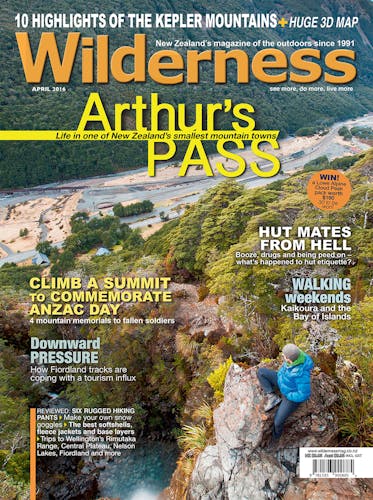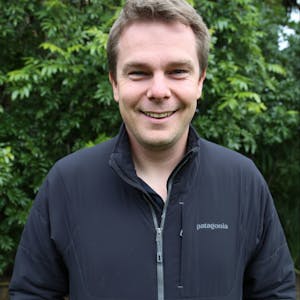With tourism at an all-time high, and expected to keep rising, how long can Fiordland’s track facilities hold out before a major overhaul is needed? Matthew Pike finds out
In January, a group of trampers from Wakatipu Tramping Club decided to take a trip to Lake Wilson. It’s a fabulous location, overlooking Lake Harris where the distant Routeburn Track meanders to its highest point before disappearing into Fiordland.

A nearly full Mintaro Hut on the Milford Track – facilities like this are reaching capacity. Photo: Kay Bayley
Six hours into the trip, the group had reached Lake Harris where they veered off the Routeburn Track to the Valley of the Trolls. It was here they breathed a collective sigh of relief. For this was the first time they’d had silence on the trip… the first moment without another soul in view.
“We were blown away by the number of day walkers on the Routeburn – there were hundreds of them,” explains club president Jude Collett. “There was never a time when we weren’t seeing people all the way to Harris Saddle, and most had day packs. On the way out the next day we saw empty cans of baked beans on the side of the track.”
It was the first time Collett had walked the Routeburn in summer for around six years. Back then she had decided the track was already too busy, yet was shocked at how much busier it had become since then.
Collett’s experience of increased numbers on Great Walks in this part of the world is consistent with the stats. Fiordland alone has had a 16 per cent increase in visitors this summer – a whopping rise compared to the four per cent it expects year-on-year.
And although DOC stats show only a moderate increase in numbers on Fiordland’s Great Walks, these only include those who stay in the huts and official campsites, which are already close to capacity. It doesn’t account for illegal campers, or the many day trippers Collett saw in late January.
Anecdotally, numbers of people taking day walks to the likes of Key Summit at the Fiordland side of the Routeburn, or to Luxmore Hut on the Kepler, are far higher than in previous summers.
Greg Lind, from DOC Te Anau, says there had already been a record number of summer visitors by the start of February this year and, while this is good for the region, it presents challenges for the department’s infrastructure; not least the unenviable task of emptying toilets.
His team alone spent $88,000 removing 40 tonnes of sewage from DOC roadside and track toilets in the Fiordland area prior to the summer season. Normally, that will suffice until the following year, but this year there were so many bums on seats that some toilets needed another emptying midsummer.
“Our roadside facilities and our multiday tracks are reaching capacity,” explains Lind. “And the challenge is how to maintain the quality of experience for people.”
With spaces in the Great Walk huts and campsites quickly filling at peak times, it means people need to book earlier to have a chance of staying there. “We hear that a lot of Kiwis do their planning late in the piece, so they miss out,” explains Lind. “People get grumpy about that, but they have the same opportunity as everyone else.”
Those who don’t book well in advance may find other means to walk the Great Walks – a situation Lind and his fellow rangers in Te Anau are well aware of. The team trialled volunteer rangers whose sole purpose was to find trampers camping illegally on the tracks.

Visitors stretch their legs in the Eglinton Valley off the Milford Highway. Photo: Robin McNeill
“In one week we discovered 19 people doing this on the Routeburn Track. We know it’s happening. Some are camping where toilet facilities are, others are just in the bush. Even with the best care in the world, this sort of camping will have an impact on the park.”
Lind says this doesn’t seem to be leading to an accumulation of litter and waste but is a behaviour his team is keen to stamp out.
It isn’t just the tracks that are close to capacity. Campsites and car parks on the Milford Road have been full at times, too. At Milford Sound, a park-and-ride car park has been built to cater for the extra vehicles at peak times. “The coach traffic is relatively static, but there’s a huge increase in cars and campervans,” explains Milford Sound Development Authority’s Andrew Welsh. “The increase in self-drives is a direct link to Tourism New Zealand promoting the South Island as a great driving experience.”
The sudden increase in tourists has created an urgency for DOC to find ways to relieve pressure on popular spots such as Fiordland. The department’s director general Lou Sanson has already said he wants to have answers to this problem this autumn.
But FMC president Robin McNeill doesn’t think answers will be found overnight. “If anyone says they have a simple solution you can say categorically they are wrong,” says McNeill. “People have been asking that question since 1984. That’s why the Kepler and Hump Ridge tracks were built. The Kepler was built to take pressure off the Routeburn but then people who did the Routeburn went and did the Kepler too.”
McNeill thinks DOC might be the victim of over-promotion of the Great Walks. “Why advertise tracks that are already near capacity? What did they expect was going to happen? Tourism New Zealand can’t just go out and sell without thinking of ways to support what they sell – that’s just ridiculous.”
DOC’s Greg Lind feels the solution is two-fold; firstly, more funding is needed to ensure his team can keep facilities – especially toilets – up to scratch as tourism increases.
The hard bit is how to secure this money. DOC has experienced a funding squeeze in the past few years – a situation that has prompted high profile figures, such as the Conservation Authority chairman Warren Parker, to suggest charging overseas visitors.
McNeill, who also works for tourism agency Venture Southland, believes this isn’t in the public interest, nor is charging higher hut fees. “The 10 per cent increase in tourists this year should see government increase DOC funding by 10 per cent,” he says. “Most tourists come to see the consequences of DOC’s work, after all.” He argues that tourism delivers enough to the New Zealand economy – $32 million in foreign exchange each day – so visitors shouldn’t be made to bear the brunt of extra costs.
Lind’s second solution to relieve pressure on Fiordland’s Great Walks is to improve the branding of the second tier tracks in the region, such as the Hollyford, the Greenstone-Caples and the Rees-Dart, when the slip that currently blocks the track at Sandy Bluff finally settles. “This part of the world is littered with some of the best tramping opportunities in New Zealand, if not the world. Numbers in other tracks are growing, but are still less than 50 per cent capacity right through summer.”

Greg Lind says Fiordland’s multiday tracks are reaching capacity
Despite his enthusiasm to see these tracks better marketed, Lind doesn’t believe adding them to the list of Great Walks is a good idea. “The Great Walk branding requires the standards to be so much higher in terms of what is provided and expected. For instance, the Rees-Dart valleys have several unbridged and unbridgeable side creeks which have caused fatalities in the past.”
Lind says there has been discussion for many years about whether to add a second tier of ‘Great Tramps’, but doesn’t believe this is a solution. “Great Tramps could present risks to unwary or naive users when compared to the existing Great Walks, or they might force DOC to address safety concerns when all that would do is incrementally diminish the tramping experience.”
Although DOC’s national office has said nothing about Great Tramps, it’s keen to promote alternative tracks to both Kiwis and visitors. “DOC is working with local tourism organisations to promote alternative options and lesser-known existing destinations,” says Gavin Walker, DOC’s director visitor and historic. Walker mentions the likes of the Old Ghost Road, Timber Trail, Aotea, Te Paki Coastal, Pouakai and Hump Ridge tracks, as trails the department aims to further promote.
“The Government has also recently committed $10 million to the construction of a new Great Walk through Paparoa National Park as a memorial to the Pike River mining victims,” adds Walker.
Robin McNeill believes any attempt to rebrand a second-tier walk needs to be done with plenty of thought. “On paper there’s no reason why the Hump Ridge Track isn’t bursting at the seams,” he says. “But it isn’t – it’s sitting there under capacity.
“Maybe they’ve not really thought through what trampers want and somehow the package isn’t stacking up for what people want to do.”
Local trampers avoid the southern Great Walks during the summer season. Jude Collett, of Wakatipu Tramping Club, says experiences of bustling tracks and full huts put most local trampers off attempting the Great Walks in the summer, as does the need to book months in advance to guarantee a place.
From the Te Anau side, secretary of Fiordland Tramping Club Liz Scott, spoke to fellow club members about the pressure on the most popular trails in the area. She says promotion of other walks may work, particularly in terms of greater publicity of alternative day walks in the region. But most trampers she spoke to disapproved of any plan to upgrade the second tier tracks to Great Walk status.
“It just makes them more expensive and another place where you can’t use your backcountry hut pass,” she explains. “People will still want to do the existing Great Walks anyway. I don’t think anyone I spoke to felt it would take pressure off the Great Walks – that’s what they thought would happen with the Kepler, but people just did that one as well as the others.”

A ranger attends to the containment tank on the toilet at Mackinnon Pass on Milford Track
The stats would appear to support the opinions of the local trampers. The Rakiura Track – the nearest Great Walk to Fiordland’s big three – has received a 13.9 per cent increase in walkers; the greatest increase of all the Great Walks. But Greg Lind says while it’s great to see other regions benefitting from this summer’s tourism boom, it hasn’t eased the pressure on the Routeburn, Kepler or Milford tracks.
With tourism predicted to increase by 20 per cent over the next five years, the pressure on these southern Great Walks and the difficulty for Kiwi trampers to secure places on them is only going to become trickier. DOC’s director general Lou Sanson says he intends to find solutions, but it sounds like he has a job on his hands and no time to waste.
We’ll know in the coming months if he can devise a plan to keep these tracks enjoyable for all who use them and available to all who wish to use them.








